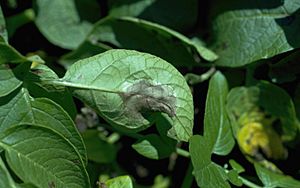Potato blight facts for kids
Quick facts for kids Potato blight |
|
|---|---|
 |
|
| Symptom of late blight on the underside of a potato leaf | |
| Scientific classification | |
| Genus: |
Phytophthora
|
| Species: |
infestans
|
Potato blight is a serious plant disease that caused huge problems, especially in Ireland in 1845. It is sometimes called late blight of potato because there are other types of potato blights.
This disease led to a terrible time known as the Irish Potato Famine. It was caused by a tiny organism called Phytophthora infestans. This organism is an oomycete, which means it's a type of "water mould." Water moulds look a bit like fungi, but they belong to a different kingdom in the world of living things.
Contents
What is Potato Blight?
The Phytophthora infestans organism caused a lot of suffering in Ireland. Over one million people sadly died from starvation. Another two million people left their homes and moved to other countries.
During the 1840s, the blight also damaged crops in Scotland and other parts of Europe. However, it hit Ireland the hardest. This was because potatoes were the most important crop for many Irish families. Also, most of the potatoes grown in Ireland were of just one type, called the Irish Lumper.
How the Blight Spread
The first times this disease was recorded were in the United States. It appeared in cities like Philadelphia and New York City in early 1843. The blight then crossed the Atlantic Ocean. It traveled with a shipment of potato seeds that were going to farmers in Belgium in 1845.
Soon, all the countries in Europe that grew potatoes were affected. But, as mentioned, the potato blight caused the most damage in Ireland. The main reason for this was the lack of genetic variability. This means that almost all the potatoes were the same. This made them all very easy targets for the disease.
Making Potatoes Stronger
Scientists are now using genetic engineering to create new types of potatoes. These new potato cultivars can resist the blight. They have found a special gene in a wild relative of the potato. This gene helps fight against most known types of blight.
Scientists can now put this resistance gene into the potatoes we grow for food. This helps make the cultivated potato varieties much stronger against the disease.
Images for kids
-
Ripe tomato infected with blight.
-
Tomato plant infected with blight.
-
Unripe tomatoes infected with blight.
-
Potatoes infected with late blight are shrunken on the outside, and corky as well as rotted on the inside.
-
Genetically modified King Edward potato (right) next to King Edward which has not been genetically modified (left). Research field belonging to the Swedish University of Agricultural Sciences in 2019.
-
Spraying in a potato field for prevention of potato blight in Nottinghamshire, England.
See also
 In Spanish: Tizón tardío para niños
In Spanish: Tizón tardío para niños











